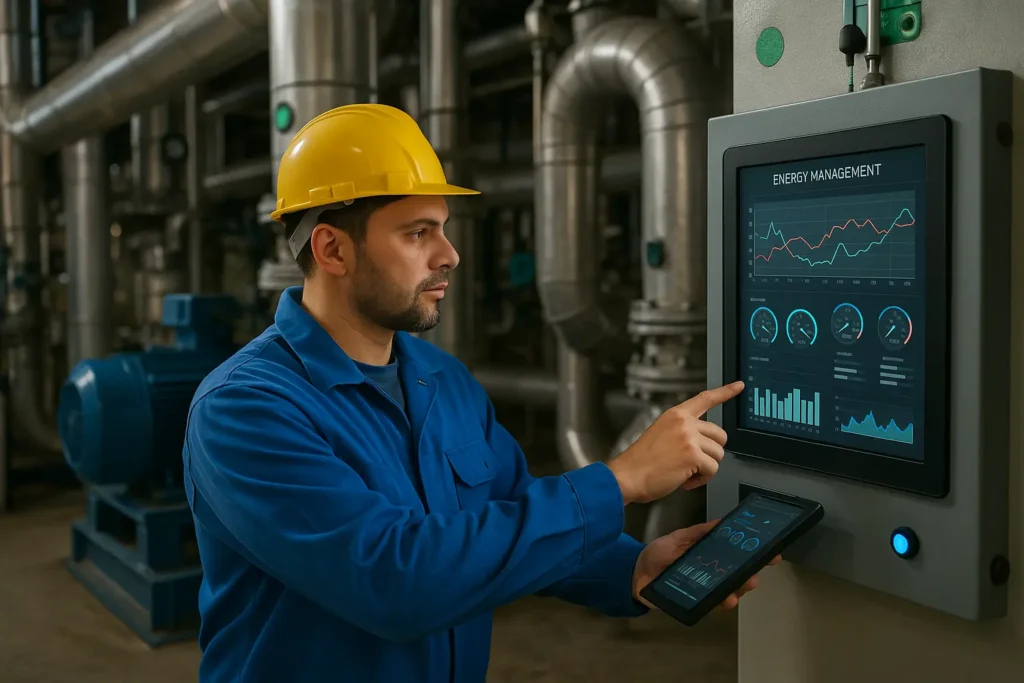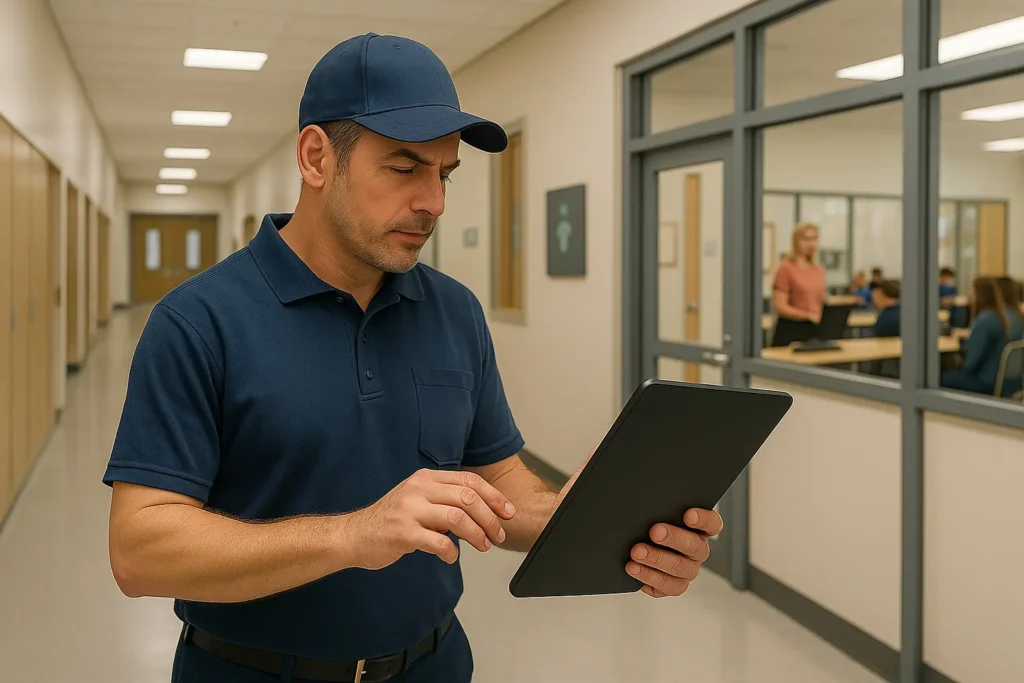Sensor-Control AI – Environment-Aware Artificial Intelligence – Decisions Based on IoT Sensor Data

Ask a question, and the AI will:
- check data from IoT sensors,
- analyze the measurement history,
- identify causes and trigger actions.
Sensor-Control AI combines the ChatGPT model with the Orange Live Objects platform – the system analyzes data in real time, detects anomalies, and automates device control.
It supports:
- energy management,
- air quality monitoring,
- control of water and heating consumption.
The result? Greater efficiency, lower costs, and improved operational resilience for your company.

Why implement an environment-aware AI assistant?
In companies, public institutions, and technical infrastructure systems, the concept of a “digital twin” is becoming increasingly common – a system that understands its environment like a human, but acts faster, without emotion, and based on thousands of data points. An environment-aware AI assistant is exactly that – an intelligent layer between IoT sensors and operational decision-making.
Below are the reasons why implementing such a solution creates a real advantage – not only technological, but above all organizational and financial.
AI that Understands Real-Time Data
The assistant doesn’t just “see” sensor data – it understands it. It analyzes measurements in real time, detects anomalies, compares them to historical trends, and responds. When temperature exceeds the threshold, the system not only sends an alert – it can identify the cause, suggest an action, or immediately trigger a corrective procedure.
Automation of Repetitive Operational Decisions
In many organizations, operators make the same decisions hundreds of times a day: turning on ventilation, cutting off flow, switching power sources. Sensor-Control AI can perform these tasks autonomously – in real time, according to rules, and without error. Where a human might hesitate or delay, the system reacts instantly.
Integration of Data from Multiple Sources into a Single Logic
Sensors, SCADA, BMS, ERP systems – data in an organization is dispersed. The assistant unifies them into one coherent stream of information, shares it with other systems, or makes decisions based on a complete picture. This enables optimization of entire facilities, not just individual components.
Human-AI Collaboration – Not Replacement
The system doesn’t act “instead of” people – it works with them. This is not Artificial Intelligence, but Cooperative Intelligence. Operators can ask questions (e.g., “Why did you turn off the cooling?”), make final decisions, override AI actions, or trigger them manually. The assistant explains its actions in natural language – so that engineers or administrators understand not only what happened, but why.
Enhanced System Safety and Resilience
A cooling unit failure? Gas concentration exceeded? Power outage at a node? Sensor-Control AI not only detects problems faster than a human, but can also predict them, suggest maintenance or emergency actions, cut power, shut off circuits, or start backup systems. This is automated response to critical situations – protecting lives, equipment, and infrastructure.
Lower Operational and Energy Costs
The assistant doesn’t get tired, forget, or rely on guesswork. It reduces heat loss, energy consumption, unnecessary wear, and excessive interventions. A single AI decision – like turning off heating in an unused zone – can generate more savings than a month of post-factum analysis.
Scalability and Adaptation to a Changing Environment
Sensor-Control AI is industry-agnostic – only data matters. Today it may support building management, tomorrow – a water treatment plant, and next – a network of EV charging stations. It can scale step-by-step, starting from a single facility or sector, up to a full infrastructure management system.
An environment-aware AI assistant is not just a data analysis tool – it’s a decision-making partner in the organization. It can act autonomously, support operators, automate routine decisions, and boost the operational resilience of your entire infrastructure. Its implementation is a step toward an intelligent, self-regulating organization.
Applications of an Environmentally Aware AI Assistant in Various Sectors
AI Assistant in Energy and Utilities Management
Energy, water, and heating systems are complex structures where a failure in one element affects the entire operational area. The AI assistant integrates data from meters, flow sensors, regulators, and valves to detect deviations in real time, balance consumption, and control the network. It enables, among others, demand peak prediction, leak detection, automatic shut-offs, and consumption recommendations. It proves effective in municipal heating systems, waterworks, power plants, and smart grids.
AI in Critical Infrastructure and Civil Defense
Hospitals, communication networks, critical resource warehouses – these are facilities that must always remain operational, regardless of the situation. The AI assistant analyzes energy availability, stock levels, generator performance, and physical and environmental safety in real time. It can send warnings about overloads, failures, or suspicious activity and activate emergency scenarios (power switching, reserve activation, access control). It is a tool supporting infrastructure resilience in both technological and climate-related crises.
Artificial Intelligence in Public Buildings and Administration
Schools, government offices, cultural centers, and event halls must be comfortable and safe – while keeping operating costs under control. Sensor-Control AI enables the management of ventilation, heating, lighting, CO₂, humidity, and occupancy – based on real-time data and current needs, not rigid schedules. This allows for energy savings during off days, improved air quality in classrooms, or reactions to excessive noise or CO₂ levels.
Use of AI in Manufacturing Plants and Industry
In industry, AI can function as a supervisory and recommending layer – without the need for integration with the production line. The assistant analyzes data from environmental sensors (temperature, vibration, dust), power supply, machine load, and media consumption. It can signal component wear, suggest maintenance, lower temperatures in unused zones, or predict the risk of failure. Thanks to contextual analysis, technical data become more than just “readings” – they become real support for maintenance.
AI in Environmental Monitoring and Resource Protection
In the era of climate change and environmental efficiency pressure, managing water, air, energy, and noise takes on strategic importance. Sensor-Control AI can process data from distributed environmental sensors – such as stormwater systems, air quality monitors, water flow sensors in forests or urban reservoirs. It can warn of contamination, reservoir drying, noise level exceedance, or rising weekend water usage. This is real support for municipalities and organizations responsible for natural resource management.
What Can an Environmentally Aware AI Assistant Do?
Sensor-Control AI is more than just a data monitoring system. It is an intelligent decision-making layer that understands the environment, interprets measurements, suggests actions, and—if granted permission—can respond autonomously. It operates not only as an observer but as an active participant in technical processes, supporting operators, engineers, or administrators in real time.
Below are the key system features that make this solution applicable in administrative buildings, critical infrastructure, and industrial facilities alike.
Reads and Interprets Data from IoT Sensors
The system collects data from sensors monitoring temperature, humidity, gas, flow, presence, light intensity, noise, utility usage, and many others. It transforms this data into actionable knowledge — e.g., “noise limit exceeded in zone A,” “increased water usage at night,” “transformer temperature is rising.”
Analyzes Context and Learns Relationships
By using language models and historical data, the AI not only detects anomalies but also understands why they occur. It learns which patterns are normal (e.g., reduced usage on weekends) and which may indicate failure. It also analyzes correlations between monitored systems — for example, it detects an increase in active power returned to the grid and thermal energy consumption, and suggests switching on heaters in a heating node to increase self-consumption. This contextual interpretation is what distinguishes Sensor-Control AI from a traditional alarm system.
Communicates in Natural Language
An operator can ask: “Why did you turn off the ventilation?”, “Do we have a leak?”, “What was the temperature in the last 2 hours?” — and will receive an understandable response. The AI can engage in data-based dialogue, support situational analysis, and explain its decisions in real time. Using the system is like interacting with an intelligent command line — there’s no need to know exact function names or parameters. You simply describe your needs contextually, and the assistant provides answers and explains every detail. It’s accessible even without technical knowledge. Sensor-Control AI is designed to adapt to the user — not the other way around.
Supports or Automates Operational Actions
Based on rules, preferences, and context, the system can:
- Issue a recommendation (e.g., “activate the backup generator”),
- Take automatic action (e.g., “closing the valve in zone B”),
- Forward a decision for operator approval.
Each of these actions can be controlled, edited, or reversed — the system does not assume full control but acts where it is safe and efficient.
Integrates Data from Multiple Systems and Sources
Sensor-Control AI can combine data from BMS, SCADA, ERP systems, meters, external APIs (e.g., weather forecasts), security systems, and emergency plans. It can also send its insights back into those systems. All of this ensures decisions are based on the full context — not just a fragment of reality.
Enhances Resilience and Reduces Risk
The system detects anomalies earlier than a human, reacts faster than standard procedures, and can correlate signals from many sources. In critical situations (e.g., fire, contamination, blackout), it can automatically switch to emergency mode and initiate preprogrammed scenarios.
Sensor-Control AI is not just a set of features — it’s a new way of thinking about infrastructure. Instead of reacting to problems, you prevent them. Instead of analyzing data after the fact — you make decisions in real time. And instead of overwhelming operators with dozens of measurements — you give them one digital co-worker who understands the situation.

What Does the Deployment of a Context-Aware AI Assistant Look Like?
The deployment of Sensor-Control AI is a process that begins with the real needs of your organization — not a ready-made template. We build a system based on data from your sensors, your infrastructure, and your decision-making scenarios. It’s an implementation conducted in a partnership model — from audit to operational results.
1. Environmental Audit and Identification of Decision Points
We begin with a meeting with your technical team — identifying the organization’s goals, reviewing the sensor map and existing data sources. We determine which measurements are critical (e.g., temperature, consumption, emergency states), where decisions are repetitive, and where automation could add value. We also assess limitations: data availability, formats, communication channels.
2. Integration with Sensors and Operational Systems
We connect Sensor-Control AI to data sources: BMS systems, SCADA, energy meters, environmental sensors, cameras, alarm systems, or external APIs. At this stage, we don’t alter your existing infrastructure — we adapt to it. We create an integration layer that enables real-time data collection and secure delivery to the AI engine.
3. Training the Assistant and Creating Scenarios
Together with the client’s team, we create a scenario catalog — e.g., “temperature above 40°C in zone C for 15 min → activate ventilation and notify the operator.” We train the AI to interpret data, detect anomalies, explain its actions, and generate understandable recommendations. We also define the communication model — voice, text, or dashboard.
4. Testing, Calibration, and Production Launch
During testing, we observe the system in real conditions: how it reacts to data, describes situations, assesses risk. We calibrate responses, verify logic, eliminate false alarms, and fine-tune scenarios. After testing, we launch the system in production — typically in phases, starting with selected areas or facilities.
5. Development and Scaling
After deployment, the system doesn’t disappear — on the contrary, its development begins. We monitor performance, respond to operator feedback, update the knowledge base, add integrations, and expand automation. The AI “learns” from your organization — the longer it runs, the better it understands your context and needs.
Sensor-Control AI does not require infrastructure replacement or long-term investments. In many cases, the first results are visible within weeks — lower resource consumption, faster response times, better reporting, and fewer operational errors. It’s a modern approach to managing technical environments — data-driven, yet focused on real-world action.
Why Implement It with Us?
Implementing AI is not just a matter of technology. It’s a process of changing how an organization operates. It requires understanding, experience, and the ability to work with data, infrastructure, and people. That’s exactly why companies choose us — not just as a vendor, but as a partner who will guide the project from diagnosis to tangible results.
We Start with Real Needs, Not with Technology
We don’t sell an off-the-shelf system. Before a single line of code is written, we conduct a thorough audit — technical and operational. We want to understand how your infrastructure works, how decisions are made, how communication flows within your organization. Only then do we design a system that truly makes sense.
We Build AI Based on Your Knowledge, Not Generic Data
Our solution is not based on “standard AI models” — it’s built on your procedures, your data, and your real context. Your AI assistant knows your measurements, threshold values, team habits, and the logic of your devices. It learns your organization — not the internet.
We Integrate with What You Already Have
We don’t require replacing SCADA systems, swapping sensors, or migrating to a new platform. We implement Sensor-Control AI as a layer above your existing infrastructure — flexible, secure, and non-invasive. That means you can move quickly and avoid downtime.
We Combine Expertise from Multiple Worlds
AI, IoT, technical infrastructure, crisis management, data analytics — our team brings together experience from all the key domains critical to your project’s success. We know how to talk both to the IT department and to a transformer station operator.
We Support Your Team — Technically and Practically
We help your team understand the system. We run workshops, teach how to ask the AI, how to interpret data, how to use the assistant in daily work. And we’re available after deployment too — continuously improving the system, updating scenarios, responding to your team’s needs.
With Us, You Don’t Just Buy Software — You Create Your Own Specialist Assistant
An assistant that understands your infrastructure, your goals, and your people. Sensor-Control AI reaches its full potential only when we build it together — step by step, from data to decision. And that’s what we do best.
Pricing – How Much Does It Cost to Implement an Environmentally Aware AI Assistant?
Basic Implementation + First Year of Operation
starting from EUR 9,000 net
The scope depends on:
- the scale of integration,
- number of locations,
- AI and IoT requirements,
- level of customization.
Annual Fee for Maintenance, Support, and Licensing
starting from EUR 9,000 net
Includes:
- ongoing technical and service support
- system and security updates
- maintenance and development of the specialized model
Additional Costs
optional, based on the evaluation plan
IoT hardware
- connectivity – LTE/5G and data hosting on Orange Live Objects are included in the service
- implementation of private 5G campus networks
- expansion to new locations and institutions
- integration with SCADA, SOC, BMS, SIEM systems
The system can be implemented in stages — using a “quick win” and evaluation model — with the ability to scale according to your organization’s needs and level of digital maturity.
Contact us — we’ll prepare a detailed quote tailored to your organization’s needs.

Jan
CEO

Przemek
COO

Kasia
Digital Value Manager

Piotr
Business Representative


